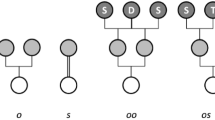Summary
Self-compatible autotetraploids are likely to set much of their seed by selfing. Formulae are presented for the frequencies in any generation of states of loci, from homozygous to quadri-allelic, considering the frequencies of selfing and of double reduction but not allowing for the effects of inbreeding depression on population structure. The changing structure of populations over generations is also explored by computer simulation, incorporating selection against inbreds but ignoring double reduction. The findings are discussed in relation to mass-selection programmes.
Similar content being viewed by others

References
Bennett JH (1968) Mixed self- and cross-fertilization in a tetrasomic species. Biometrics 24:485–500
Demarly Y (1961) In: Valdeyron G. Genétique et amélioration des plantes. Bailliere, Paris, pp 318–335
Gallais A (1968) Interactions between alleles and their variability in autotetraploid cross-fertilised plants — consequences for selection. 5th Conf European Association Res Plant Breed, Milan, pp 312–323
Glendinning DR (1976) Neo-Tuberosum: New Potato breeding material. 4. The breeding system of Neo-Tuberosum, and the structure and composition of the Neo-Tuberosum gene-pool. Potato Res 19:27–36
Author information
Authors and Affiliations
Additional information
Communicated by A. R. Hallauer
Rights and permissions
About this article
Cite this article
Glendinning, D.R. Some aspects of autotetraploid population dynamics. Theoret. Appl. Genetics 78, 233–242 (1989). https://doi.org/10.1007/BF00288805
Received:
Accepted:
Issue Date:
DOI: https://doi.org/10.1007/BF00288805



